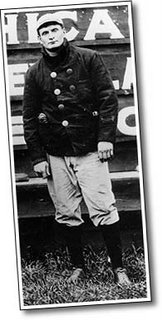
Davy Jones was one of many old-time ballplayers interviewed by Lawrence Ritter in the 60's (for his marvelous oral history book, The Glory of Their Times) about their lives in turn-o-the-century baseball;
"Oh. the game was very different in my day from what it's like today. I don't mean just that the fences were further back and the ball was deader and things like that. I mean it was more
fun to play ball then. The players were more colorful, you know, drawn from every walk of life, and the whole thing was sort of chaotic most of the time, not highly organized in every detail like it is nowadays.
Back at the turn of the century, you know, we didn't have the mass communication and mass transportation that exist nowadays. We didn't have as much schooling either. As a result, people were more unique then, more different from each other."
George Edward "Rube" Waddell was unarguably one of the top 5 pitchers who ever lived, leading the American League in strikeouts 6 YEARS IN A ROW between 1902 and 1908 (349 in 1904 which stood as the record until Koufax broke it in 1965), with an incredulous lifetime ERA of 2.16! Now keeping in mind the 20 million dollar salary of today's superstar Alex Rodriguez; Rube's top salary was about $2500 and in consideration of Rube's "odd" behavior and unpredictable attendance to scheduled pitching stints with the Philadelphia Athletics, his manager, the venerable Connie Mack, took it upon himself to distribute Rube's salary to him in one dollar increments.
Hall of famer and contemporary of the Rube, Sam Crawford, puts it like this:
"How good he'd have been if he'd taken baseball seriously is hard to imagine. Like I say, it was always just a game with Rube. He played 'cause he had fun playing, but as far as he was concerned it was all the same whether he was playing in the Big Leagues or with a bunch of kids in a sandlot."
Rube was more than once delayed in making his appearance to the mound because he was found in a marbles match with kids under the grandstand.
For weeks at a time, Rube might be out fishing, tending saloon (Rube certainly wouldn't neglect to serve himself), appearing in vaudeville skits, subduing villains on the theatrical stage, or wrestling alligators.
Rube was a Big Kid (in marquee-sized capitals) who managed to blaze his way to glory with a hopping fastball, and an unhittable curveball that apparently could only be caught by one catcher, Rube's partner in crime, Ossie Schreckengost - "Schreck". Alas, even Schreck had to draw the line somewhere with Rube. He approached Connie Mack and demanded that if he were to room with Rube there had to be a clause written his contract that the flakey inhabitant of the upper bunk would not be permitted to eat Animal Crackers in bed. And so it came to pass...
Rube chased after women, entering into marriages with a meteoric zest and exiting that institution just as quickly. Whether animal crackers entered the picture...only the Sphinx knows. We know he was once brought to trial for heaving a flat-iron at his in-laws. (hmmmm...)
Sam Crawford shares an "opposing player" memory of Rube:
"The main thing you had to watch out for was not to get him mad. If things were going smoothly and everyone was happy, Rube would be happy too, and he'd just go along, sort of half-pitching. Just fooling around, lackadaisical, you know. But if you got him mad he'd really bear down, and then you wouldn't have a chance. Not a chance."
"Hughie Jennings, our manager in Detroit, used to go to the dime store and buy little toys, like rubber snakes or a Jack-in-the Box. He'd get in the first base coach's box and set them down on the grass and yell, 'Hey, Rube, look.' Rube would look over at the jack-in-the-box and grin, real slow-like, you know. yeah we'd do everything to get him in a good mood and to distract him from his pitching."
Waddell was particularly fond of fire engines and fires. He would leave a game midway, dashing out of the dugout and out of the park in pursuit of a fire engine.
Connie Mack related this to the Saturday Evening Post in 1936:
"I had to keep an eye on him to keep him from joining up with the fire department in any town we happened to be playing in. He always wore a red undershirt, so that when the firebell rang he could pull off his coat, thus exposing his crimson credentials, and gallop off to the blaze, where he would try to direct operations by ringing commands, whether anyone obeyed them or not." There were times though, when Rube would throw Mack a curveball in the dissapearance arena.
"Another time when he was missing during a train trip, he returned to us as the drum major of a band marching up the main street, a look of ineffable bliss on his face. He(then in the heat of glory?)posed in a show window as an automoton."
Rube was never one to shirk from danger and sincerely meant well despite neglecting such formalities as "credentials". Again, from Connie Mack's reminiscence: "Danny Hoffman always gave the Rube credit for saving his life. ...Tannehill threw a ball that hit Danny on the temple, and he fell to the ground like a pole-axed steer. Someone went for an ambulance, and the players crowded around in aimless bewilderment. Somebody said that Danny might not live until the doctor got there. Pushing everybody to one side, (Waddell) placed Danny over his shoulder and actually ran across the field. And Danny was no lightweight, and was unconscious to boot.
The Rube found a carriage outside, commandeered it with ferocious threats to the driver, and rushed Danny to a hospital. The Rube sat by Danny's bedside the greater part of the night, still in his uniform holding ice to Danny's head to ease his suffering."
After a decade in the majors, alcoholism and erratic behaviour drove Rube out of the league. He met his end in 1913, falling ill to pneumonia contracted from volunteer work piling sandbags in an icy river that threatened a Texas community with a disastrous flood.
Shortly before his death some ballplayers located him in the sanatorium where he was a patient. Barely recognizable and thin as a rail, Rube told them,"I'll be over there tomorrow to show you guys how to run. I've got my weight down to fighting trim."
Ossie Schreck saw to the epitaph on his headstone: "Rube Waddell had only one priority, to have a good time."
























